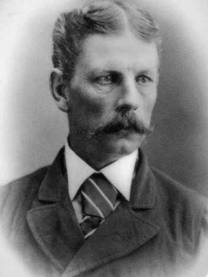
CAPTAIN
CHRISTOPHER WILLIAM LACEY, IARO
Kimberley John
Lindsay & Edward De Santis
A
SON OF THE RAJ
Christopher
(Christie) William Lacey was born on 28 December 1889, at Simla, India.
Christopher‘s father Joseph was an accountant in the Accounts Branch of the
Public Works Department (PWD). Joseph
Edward Lacey was born at Bangalore on 8 June 1859 and married Emily Dracott on 6
March 1884 at Indore. By 1902, he
had advanced to Deputy Examiner (Class I). Eventually young Christopher would
follow his father into the PWD.
Joseph
and Emily‘s first-born was Edward Dracott Lacey, born 6 December 1884 and
baptised at the Indore St. Anne Church on
6 Jan 1885. He was followed
into the family by Richard Harry Dracott Lacey, born 11 January 1887 and
baptised at Quetta, 2 Feb 1887.
C. W. Lacey’s
mother, Emily Lacey,
née Dracott, was twenty-six at the time of Christopher Lacey‘s birth
at Simla in 1889. He had been preceded into the family a year earlier by
Charlotte Emily Lacey (born 29 April 1888, and baptised at Christ Church, Simla,
on the same day). Finally, a younger
brother arrived two years later: Frank Herbert Lacey (born 1892 at Simla). The
good-looking Frank later attended RMC Sandhurst and
was awarded the MC during the Great War, when serving with the R.E.
A delightful
portrait image of C. W. Lacey’s
rather imposing-looking grandfather, Benjamin
William Lacey, survives.

Figure 1. Benjamin William
Lacey
(Photograph courtesy
of the Lacey Family Tree)
AN
OLD BEDFORDIAN
In 1902 the twelve
year-old Christopher left India to complete his schooling at an English Public
School. This was the affordable Bedford Grammar School, which he attended from
1903 to 1909. Bedford
was a favourite homing-in place in those days for “Families of Empire” who
were less well-off, and several Lacey boys attended Bedford School.
BEDFORD
SCHOOL SPORTS
Bedford School was ideally suited to the well-built and handsome Lacey
brothers, both being nominated as Monitors (Prefects), and excelling in all
manner of sports. They were both in the unusually-named House, Paulo-Pontine,
and took full advantage of all the amenities of that lesser Public School. The
younger Frank was academically brilliant (despite both spending most of their
time on the playing field), whereas Christopher’s results are not known –
although he was plainly good enough to have entered the City and Guilds
Institute.
It is not an exaggeration to say that the Lacey brothers dominated the
Rugby scene for the school during 1908-09. Their exploits on the playing fields
and elsewhere were faithfully reported by the school magazine ‘The Ousel’
(Bedford School is situated on the River Ouse).
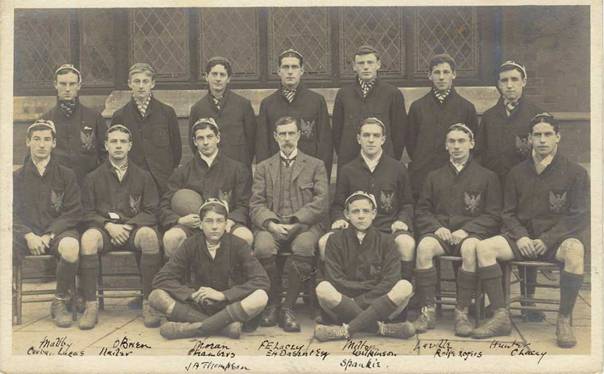
Figure
2. The Bedford School Rugby 1st
XV, 1908-1909
(Photograph
courtesy of the Bedford School)
The following notices were printed in “The Ousel” for the years from
1906 to 1909 with mentions of the Lacey boys:-
1906
October
1906: School 3rd XV v. R.A.M.C. F.C. ‘This match, played on the
School ground, after a very even game, ended in a win for the School 3rd.’
‘Early in the second half, the “Medicals” opened their score...’ ‘Yet
another try was added to the “Medicals” score (unconverted), and the score
remained till “no-side” 13-11.’
‘School
3rd XV: Costin; Wall; Briggs; Noble; Courtenay; Burton (Capt.);
Lightfoot; Munro; Raynor; Deal; Lacey i;
Lacey ii; Hanmer; Laville; Goldney-Baker.’
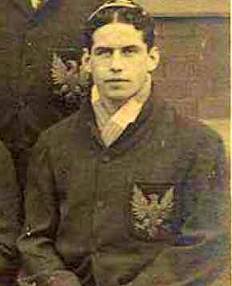
Figure
2 . C.W. Lacey, 1908-1909 Bedford
Rugby 1st XV.
(Photograph
courtesy of the Bedford School)
1907
20
November 1907: The School v. Hertford College, Oxford. ‘The School won by
three goals four tries to a goal (27-5).’
‘The
School. – L. J. Lightfoot; R. Wilkinson; W. Earle; L. Pointer; B. D. Costin;
W. B. McWha; H. O. Sutherland; R. A. Thompson; G. H. Chambers; S. Nailer; R. G.
Rolfe-Rogers; C. W. Lacey; P. Corban-Lucas;
F. H. Lacey; A. S. Sherwood-Smith.’
23
November 1907: School 2nd v. Town “A”. ‘This match, played on
the Sports ground, Kimbolton Road, was very evenly contested, and ended in a
draw. For the School, tries were scored by Powell (2), C. W. Lacey and Milton: all four were successfully converted by
Powell (20 pts.).’
School
2nd XV. – C. F. Maltby; R. Powell; J. Hunter; Milton; Laville;
Earle; Gage;
C.
W. Lacey; Wemyss;
Clair-Smith; J. A. Thompson; Woods; Somerville; Candy; Goldney-Baker.’
27
March 1907: HOUSE
RACES. ‘Both the
Head Master’s Cup and the Master’s Cup go to Paulo.’ For Paulo-Pontine the
following won their heats:
Seniors
– Hurdles:- A. W. B. Gompertz; Costin; C. W. Lacey; E. T. Warren; Noble;
F.
H. Lacey; H. A.
Reid; Capon. ‘Flat – Hutton; R.
Powell, T. W. H. Lansberry; Rolfe-Rogers; Costin; Baker; C.
W. Lacey; Noble; Capon.’
1908
22
January 1908: The School v. R.A.M.C. ‘This resulted in an easy win for the
School by 41-3... C. W. Lacey.’
26
February 1908: The School v. Merchant Taylors. ‘Our only School match of the
term ended in an easy victory for the School by 10 goals and 3 tries to nil
(59-0).’
‘C.
W. Lacey scored and R. C. Wilkinson (later Head of School) again added the
major points (54-0).’
THE
DAILY GRAPHIC: 27 FEBRUARY 1908
‘The famous nursery for
Rugby “internationals,” Bedford Grammar School, added fresh laurels to its
Football fame on 26 February by beating Merchant Taylors’ School...’
‘”The finest school team in England,” was the verdict of Mr C. H. R.
Henman, whose efficient refereeing in the match gave general satisfaction. And
much of the credit for such form and finish is due to one of the masters, Mr E.
Hastings Dasent, whose name is well known in Rugger circles. He must have been
well pleased with the performance of his apt pupils yesterday, seeing as they
scored ten goals and 3 tries – 59 points – and that on a ground like a
quagmire through persistent rain.
‘Bedford boys, true to tradition, play a gentlemanly, sportsmanlike
game. Open play is the order, pretty is the spectacle, and satisfactory are the
results...’
‘R. C. Wilkinson, amid wild cheers, raced over the line just in time
with the try of the season, and by gaoling placed the record at 1.003 points. In
all 58 points were scored, the other try-getters being R. Powell, G. S. Hutton
(two), W. B. R. McWha, B. D. Costin and C. W. Lacey. Four of the
seven were converted by R. C. Wilkinson. H. O. Sutherland, the popular captain,
was the recipient of vigorous congratulations.’
The
following are additional notices in The Ousel which mention the Lacey boys:
19
March 1908: CROSS-COUNTRY
RUN. The School v.
Keble College, Oxford. ‘1st
Mr R. S. Seacombe (Keble); 4th F. H.
Lacey (School); 8th C.
W. Lacey (School)...’
3 &
4 April 1908: ATHLETIC SPORTS.
One Mile. “Lutyens” Challenge Cup. ‘1st R. G. Rolfe-Rogers (5
min 21 secs); 2nd L. M. Handley; 3rd D. M. Spankie; 4th
C. W. Lacey.’
26
September 1908: 1st XV v. Olney. ‘After a line-out from touch, C.
W. Lacey scored, and Wilkinson added the major points (15-3).’
6 October 1908: The School v. Rosslyn Park. ‘C.
W. Lacey.’
17 October 1908: The School v. St. Paul’s School. ‘Upon resumption C. W. Lacey
scored a try which T. G. Laville converted (30-0).’
PRO-MONITOR
27 October 1908: ‘Monitors, etc., Xmas Term, 1908.
Monitors
– H. C. B. Wemyss (pron. ‘weems’ and a future General: Sir Henry Colville
Barclay Wemyss, KCB, KBE, DSO, MC; 1891-1956), etc.; Pro-Monitors – C.
F. Maltby; C. M. G. Ogilvie; C. W. Lacey;
R. H. A. Kellie; D. B. Candy; J. M. Lee.’
1909
1st
XV CHARACTERS, SEASON 1908-09
‘...
C. W. Lacey
(Paulo-Pontine). – Gets through a great amount of work; good both in and out
of the scrum; takes well from touch.
F. H. Lacey (Paulo-Pontine). – A heavy forward, good in the open;
follows up well, but
might do a little more work in the scrum.’
23 January 1909: 1st XV v. Mr. F. S. L. Spalding’s XV. ‘C.
W. Lacey.’
3 February 1909: The 1st XV v. Mr. T. R. Treloar’s XV. ‘C.
W. Lacey’.
10 February 1909: The School v. Merchant Taylors School. ‘The School
pressed until
Chambers got possession and passed to C.
W. Lacey, who crossed; Wilkinson
majorised (16-0).’
20 February 1909: The School v. Harlequins ‘A’. ‘C.
W. Lacey’
27 February 1909: The School v. Hertford College. ‘Hertford then
pressed and looked
like scoring, but our forwards relieved and C.
W. Lacey scored.’
BEDFORD
TOWN FOOTBALL CLUB
The athletic
Christopher Lacey continued to play Rugger after leaving school. He was on the
Bedford Town team for three years until leaving for India in 1913. (This was
recorded by the local Bedford Times on 7 September 1945.)
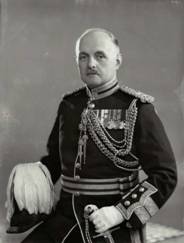
Figure 3. General Sir Colville Wemyss, KCB, KBE, DSO, MC (1891-1959).
(Photograph courtesy of Wikipedia.com)
H. C. B. Wemyss, one of Laceys school and Rugby contemporaries, distinguished himself during the Great War with the Royal Engineers (DSO, MC), was subsequently knighted and reached the rank of General. The photograph was taken in Feb 1939. In 1941, Wemyss was appointed as the Head of the British Army Mission to Washington – and was replaced by General Sir John Dill in 1942.
A
DIPLOMA FROM THE IMPERIAL COLLEGE, LONDON
In
1911, Emily Lacey, Charlotte Lacey, Christopher William Lacey and Frank Herbert
Lacey were all residing at 21 Devon Road, Bedford. Additionally,
two Dracott nephews (one also having been born in Simla), shared rooms
there.
Christopher
continued his education in London - at the City and Guilds Institute, Imperial
College, from 1909 to 1912. He gained a Diploma and the initials A.C.G.I.
behind his name: Associate of the City and Guilds Institute (Graduate of
Imperial College, London).
START
OF HIS CAREER
From
1912 to 1913, the young Lacey was a Pupil with J. J. Webster, Construction
Engineers, in London. During this time he spent 8 months in the Office, and 10
months in or on Works. He was admitted Stud.
Inst. C. E. in November 1912 on the recommendation of J. J. Webster.
John
James Webster (1845-1914) was a
civil engineer who specialised in designing bridges. His last work was
Warrington Bridge at Bridgefoot – one of the earliest reinforced concrete
bridges.
THE
INDIAN SERVICE OF ENGINEERS
The long-awaited London Gazette announcement read as follows: ‘C. W.
Lacey has been appointed an Assistant Engineer in the Indian Public Works and
State Railways Departments. W. J. Hamilton Hunter has been made a Stipendiary
Magistrate for the Colony of Fiji.’
C.
W. Lacey joined the Indian Service
of Engineers as an Assistant
Engineer, on 1 October 1913. He gained experience as an Assistant during
1913-18, under Sir Bernard Darley: in the Office, one year; on or in Works, 3 ½
years (Mirzapur Canal Systems).
Sir
Bernard D’Olier Darley, CIE (1880-1953),
Indian Public Works Department. Educated at Trinity
College, Dublin. 1908-18 constructed the Mirzapur Canal Systems in the United
Provinces. Retired 1937. 1938-39 Air Raid Precautions Dept., Home Office.
LANGUAGE
LEAVE DURING THE WAR
Lacey
took language leave in India from 19 July to 18 October 1915. He managed to pass
the examination in Urdu (by the Higher Standard) in October 1915. In April 1916,
he also passed the Higher Standard examination in Hindi. These were obviously
essential hurdles which had to be taken, for a career in India.
At
the same time, however, the War was raging in Europe and elsewhere, and his
younger brother Frank was on Active Service – even joining the Canadian
Expeditionary Force to fight in France, and subsequently transferring to the
Royal Engineers (MC, 1918).
HELD
CHARGE OF 5TH SUB-DIVISION DURING 1916
From
28 January to 4 September 1916, the twenty-six year old Lacey held charge of the
5th Sub-Division, Mirzapur Canal Division, in addition to his normal duties.
He passed the
so-called professional examination on
20 July 1916. This was followed by brief Privilege Leave which he took in India
from 5 September to 6 October 1916.
Christopher
Lacey went on to serve almost a quarter of a century with the Irrigation Branch,
Public Works Department, eventually becoming a Superintendent Engineer, United
Provinces. This service was
recognised by the award of both the 1935 Jubilee (‘Lacey,
Christopher William, Indian Service of Engineers, Executive Engineer, Public
Works Department, Irrigation Branch, United Provinces‘) and the 1937
Coronation medals.
WAR
SERVICE 1918/19
Lacey
was a member of the obligatory Indian Volunteer Force up until 1918. Remarkably,
he was commissioned into the Indian Army Reserve of Officers (IARO) very late in
the war, perhaps because his services with the Public Works Department (PWD) had
been more urgently needed.
As
one of several undermentioned Gentlemen
( London Gazette of 11 October 1918), Christopher
William Lacey was commissioned 2nd Lieutenant into IARO (Infantry Branch), dated
28 January 1918. Unusually, in the
same 11 October 1918 London Gazette, C. W. Lacey was immediately given the IARO
rank of 2nd Lieut./Temporary Captain
(28 January 1918). Furthermore, the
IARO Register indicated that C. W. Lacey (Assistant Engineer, Public Works
Department, United Provinces; Volunteer; educated in England;
languages, Urdu and Hindustani) –
was to be appointed Commandant, 10th Labour Corps.
The
twenty-nine year old Capt. Lacey apparently helped to raise 10th Labour Corps,
then subsequently served with the 101st Labour Company in Southern Persia as a
Lieutenant (substantive rank dated 28 January 1919): London Gazette, 1 July
1919.
THE
SYKES MISSION TO PERSIA
Several
units under Major-General Sir Percy Sykes were at Bandar Abbas on 30 April 1918
– with a mere handful of forty British officers all told, presumably including
C. W. Lacey, IARO (101st Labour Company), now with the substantive rank
of Lieutenant:-
23rd Sanitary
Section.
Base Hospital.
D Company, Basra
Camel Corps.
Part of 10th Camel
Corps.
Jat Bullock Corps.
100th Labour Corps.
101st Labour Corps
(Officers in this unit included J. D. Warburton, W. G. Kelly; E. O. Gilbert; A.
L. Simons; W. H. Macredy, etc.).
Indian
Army Reserve of Officers, rank of Captain. On service in S. Persia and India.
Construction of roads, etc.
Only
8 Labour Corps units were deployed to South Persia (as opposed to 54 in France;
19 in Mesopotamia; 2 in Salonika; and one in East Persia).
By 31 December 1919, India had supplied 348,735 non-combattants of every
conceivable category in Mesopotamia. Some
of these, such as the Indian Labour Corps and Indian Porter Corps positioned at
Bushire, S. Persia, and along the Baghdad – Khanikin – Hamadan route, would
also play a role in the undeclared war in Persia.
BELATED ISSUE OF WAR MEDALS
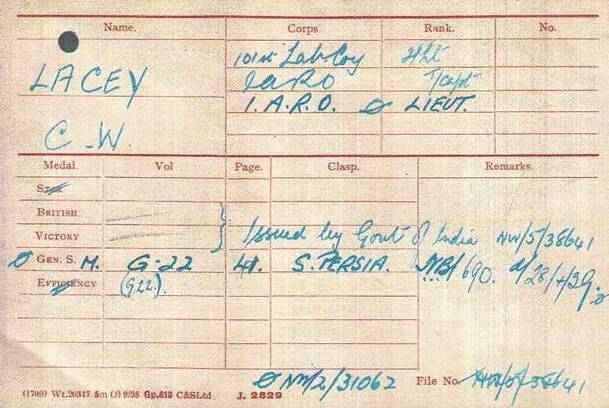
Figure 4.
The Medal Index Card of C.W. Lacey.
(Image courtesy of Ancestry.com)
Additionally
noted, the General Service Medal GVR (GSM 1918), clasp S. PERSIA, which was
despatched on 28 April 1939. The address on the back of the Medal Index Card
is shown as 5 Upherds Lane, Ely, Cambs, and the date, 28 April 1939.
As far as the GSM is concerned, there are two more documents, both
different:-
The
first was made out at Simla in November 1925 by a Major Williams for the
Military Secretary, confirming medals to three Officers, including the GSM with
S. PERSIA clasp to Lieut. C. W. Lacey, IARO –
and years later endorsed as despatched on 28 April 1939.
The
second document is an altogether more important-looking one, which devotes the
entire page to 2nd Lt (T/Capt.) C. W. Lacey, 101st Labour Company, IARO and his
GSM and clasp S. PERSIA. The Theatre
of War was typed in as South Persia,
followed by 25th January 1918 to 31st
December 1918. These dates, however, were crossed out by hand and replaced
by 1918. Later, the words prior
to 11. 11.1918‘ were added by hand. This was made out at New Delhi on 1st
December 1938, and was signed by H. E. Bloodworth.
THE
MEDALS
Lacey’s
medals are shown in Figure 5 below. They
include (from left to right): The British War Medal 1914-18 (CAPT.
C. W. LACEY.); Victory Medal (CAPT.
C. W. LACEY.); General Service
Medal GVR clasp ‘S.
PERSIA’ (LIEUT.
C. W. LACEY, I. A. R. O.); 1935
Jubilee Medal GVR; 1937 Coronation Medal GVIR. Originally mounted as worn and
named to him as shown above.
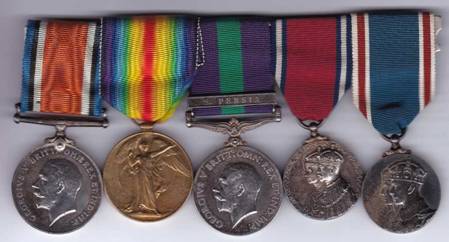
Figure 5.
The Medals of C.W. Lacey.
(Photograph from the Lindsay collection)
RELEASED FROM THE INDIAN ARMY RESERVE OF OFFICERS
On
23 March 1919, the erstwhile Captain Lacey was released from the IARO.
He was able to resume his duty with the Indian Service of Engineers, as
Assistant Engineer under Mr Lane, and was employed on a general reconnaissance
survey in connection with the development of hydro-electric power in the United
Provinces.
The
year 1920 saw Lacey as Assistant Engineer to Mr Morphy, concerning construction
of the Birngoda Weir and Ganges Canal Headworks, River Training Works,
Buildings, etc.
EXECUTIVE
ENGINEER
C.
W. Lacey was promoted to Executive Engineer in October 1922 - at a time when
numerous less fortunate wartime ex-Officers were unemployed. During 1920-23,
Executive Engineer Lacey was in charge of the Bhognipur and Cawnpore Canal
Divisions, as well as carrying out general administration and the maintenance of
canal systems.
TENNIS
WEEK IN 1922
The Ousel, 1922: Old Bedfordians’ Tennis Week. ‘The following played,
but the match was stopped by rain:- J. P. White, C. Grant; C. Franklin, H. O.
Page; C. W. Lacey, L. H. Dasent;
etc., etc.’
CO-RESPONDENT
IN A 1922 DIVORCE CASE
On
12 May 1922, a Petition was filed in the High Court of Justice, London, in the
Divorce of George Albert Newman and Marjorie Bradford Newman, with
Christopher William Lacey named as co-respondent. A Decree Nisi was issued on 29
November 1922, and the Final Decree on 4 June 1923.
The
marital drama began on 3 July 1913, in the Parish of Kensington, London, when G.
A. Newman, 44 (Gentleman), of Penfield
Hall, Braintree, son of deceased Farmer W. S. Newman, had married the much
younger Marjorie Bradford Silverthorne, 23 (Spinster), born 1890 at Bangalore, of 29 Kensington Court, daughter
of Major Bradford Silverthorne.
It
is worth mentioning that George Newman was twenty-one years older than Marjorie,
and has been described as old money.
Nonetheless, the perhaps lop-sided couple’s marriage lasted eight years and
produced a daughter (who apparently stayed with the Newman family after the
divorce).
CHRISTIE
MARRIED MARJORIE IN BENGAL: 1923
The
handsome Christopher William Lacey, 34, married the freshly-divorced Marjorie (Madge)
Bradford nee Silverthorne, div Newman, 33, at Mussoorie, Bengal, on 30 June
1923.
Four
years later, their only child arrived. Charmian N. Shenton, nee Lacey
(1927-2017), subsequently became a notable architect (see Figure 6 below).
SARDA
CANAL PROJECT UNDER SIR BERNARD DARLEY
1923-31
saw Lacey in charge of several Divisions, working under Sir Bernard Darley
again: this time on the Sarda Canal Project. His duties included the design and
construction of canal works, channels, chains, bridges, falls regulators,
drainage crossings, canal heads, buildings and roads.
The
1926 Combined Civil List for India, shows C. W. Lacey On leave. Marjorie (37) in fact gave birth to their daughter,
Charmian, in 1927.
The Ousel, 1926: OLD BEDFORDIAN WAR MEMORIAL.
List of subscribers. ‘... Lacey, C. W.; Lacey, F. H.; Lacey, R. H. D.; etc.,
etc.’
IN
CHARGE OF LUCKNOW AND AGRA CANAL DIVISIONS
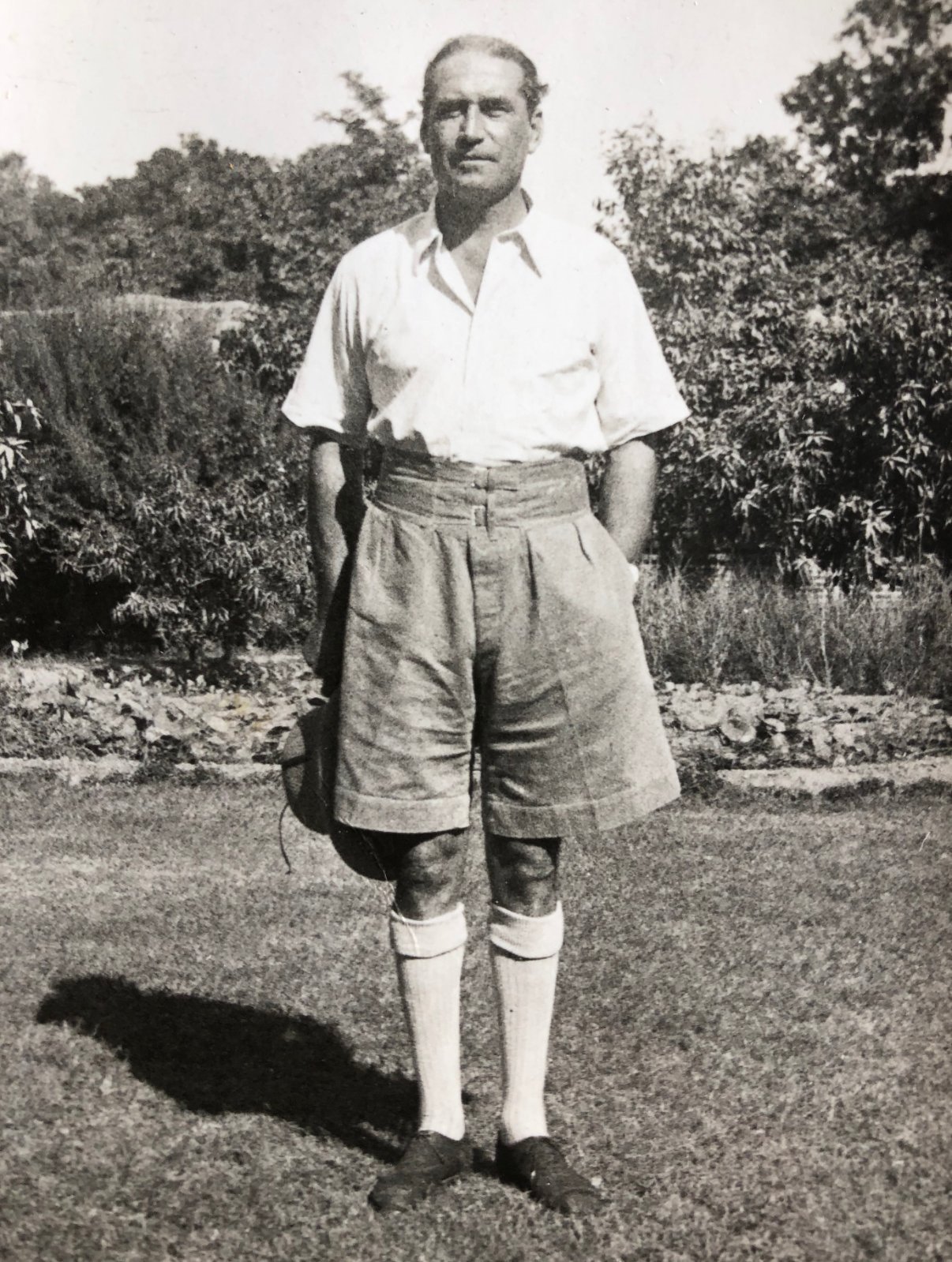
Figure
6. C.W. Lacey in Lucknow.
(Photograph from the Lindsay collection)
During
the 1931-34 period, under Mr F. Anderson, Chief Engineer, and Sir William Stampe,
saw C. W. Lacey in charge of the Lucknow and Agra Canal Divisions, including
administation of the canal systems.
Sir
William Leonard Stampe, CIE, K-i-H (1882-1951), Indian Service of Engineers. In
1914-1917 W. L. Stampe served with the Indian Sappers & Miners in India, and
1917-19, in Palestine. Post-Great War, Stampe was Chief Engineer and Sec. to
Govt. of United Provinces. Died of injuries suffered in an air crash. Died
Colyton, Devon.
During
the 1934-36 period Executive Engineer Lacey was in charge of Development of the
Ganges Canal hydro-electric grid system. In
1936 he officiated as Superintending Engineer, IV Circle. This was followed
during 1936-37 by his tenure as Executive Engineer, Unao Canal Divisions.
The Ousel, 1937: Old Bedfordians’ Dinner. This was held at the
Connaught Rooms, Great Queen Street, London, on Wednesday, 26 May 1937. The
President of the Club, Field- Marshal Sir Cyril J. Deverell, GCB,
KBE, presided. 135
O.Bs. and fourteen officials attended, including: ‘03-09 C.
W. Lacey, Esq., A.C.G.I., I.S.E.;
03-09 Major F. H. Lacey, MC;
etc., etc.’
The Ousel, 1938: Old Bedfordians’ Dinner. This was held at the
Connaught Rooms, Great Queen Street, London, on Wednesday, 25 May 1938. The new
President of the Club, Sir Edward Crowe, KCMG, presided. 124 O.Bs. and eight officials attended, including: ‘03-09 C.
W. Lacey, Esq., A.M.INST.C.E.;
03-09 Major F. H. Lacey, MC; etc., etc.’
ENGINEERS‘
WHO’S WHO 1939
Immediate
preceding the Second War, and following a moderately successful career with the
Indian Public Works Department, Lacey returned Home.
Happily, he rated an entry in the 1939
Engineers Who’s Who:-
Lacey,
Christopher W., A.M.Inst.C.E., A.C.G.I. (Civil Eng.) District Engineer, South
Level Area, Ely. River Great Ouse Catchment Board, 26a St. Mary’s Street, Ely,
Cambridgeshire. Private Address: 5 Upherds Lane, Ely. Age: 48.
Career: Bedford School, 1903-09; City and Guilds, 1909-12; Pupil with J.
J. Webster, Consultant Engineers, London, 1912-13; Indian Service of Engineers,
Irrigation Branch, United Provinces, India 1913-37, Assistant to the
Superintendant Engineer.
A
ROTARY WAR: 1943-1944
During
this middle of the Second War period, C. W. Lacey is shown as having been a
President of the Rotary Club of Ely, 1944-45 (this was a normal term of office).
This position was taken on, in addition to his normal duties as District
Engineer and his seat on the River Great Ouse Catchment Board.
The following
article appeared in the 7 September 1945 Bedford
Times:-
Mr
G. J. S. Turner, A.M.I.C.E, (O.B.), of 49 Beverley Crescent, Bedford,
has resigned his post with the River Great Ouse Catchment Board. He has
been Assistant Engineer with the Great Ouse Catchment Board since 1933, and has
been acting as District Engineer from October, 1944. He is resigning to take up
an appointment as Civil Engineer, Public Works Department, Kenya.
Mr Turner is succeeded as District Engineer by Mr C. W. Lacey, M.I.C.E.,
who has lately been District Engineer at Ely. Mr Lacey is also an Old Bedfordian.
He was at Bedford School from 1903 to 1909, and afterwards played Rugger for
Bedford Town for three years, until leaving for India in 1912. He is at present
living at 45 De Parys Avenue, Bedford.
NB: De Parys Avenue is situated in one of Bedford’s most prestigious
tree-lined avenues… (De Parys Hotel).
NATURALISATION
IN 1949
A
seemingly unusual and obviously irksome Natualisation procedure took place,
post-Second War (fee paid on 11 July 1949: 10/-). No doubt due to his having
been born in Simla, India, C. W.
Lacey had been obliged to apply for Registration as a Citizen of the United
Kingdom.
He
wrote: I was born at Simla, India, on 28 December 1889 – of British Parentage
– my father J. E. Lacey having been born in India too. My home has been in
England since 1902!
Lacey
gave as his, and his wife’s, address, 20 Richmond Road, Bedford. He added: Have
been a householder in Ely (Cambs.), and Bedford, since October 1937.
FRANK’S
DEATH
The
Bedford Times (DEATH
OF LIEUT.-COL. F. H. LACEY) of 24
November 1950 had a lengthy obituary for Christopher’s younger brother, Frank,
who died on 10 November, aged 67.
He
was at Bedford School from 1903-09 and played in the First XV with such
personalities as G. H. Chambers, R. C. Wilkinson, H. K. F. Nailer, H. C. B.
Wemyss, and P. H. Lawless…‘
He
had served on the Committee of the Old Bedfordians Club, retiring by rotation
this year. His son is also an Old Bedfordian and his grandson is at the School
at present. Frank was the youngest of three brothers, of whom only one, Mr C. W.
Lacey, O.B., of 20 Richmond Road, Bedford, is living.
FINAL
MOVE TO KENT
Christopher and
Madge Lacey’s retirement address from 1957, was at 27 King Harold’s Way,
Bexleyheath, Erith, Kent.
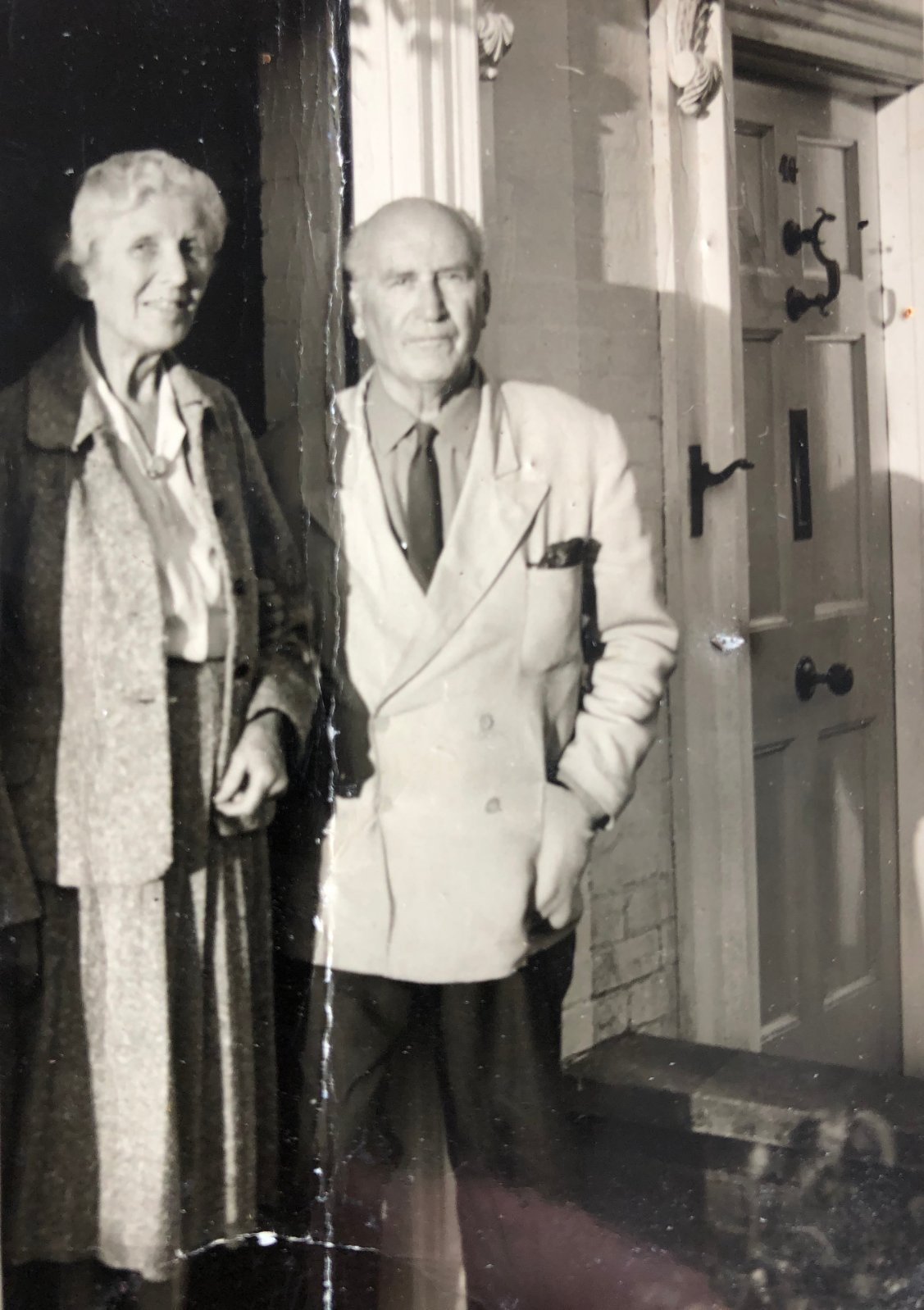
Figue 7. Christopher and Madge in
Later Years
(Photograph from the Lindsay collection)
DEATH
AT DOVER
Christopher William
Lacey died in December 1966 at Dover, Kent, aged 77.
His widow Marjorie,
died ten years later, aged 86, and their talented daughter Charmian, died in
2017, aged 91.
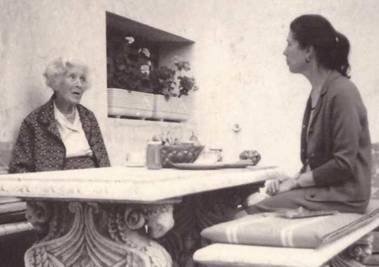
Figure 8.
Marjorie Lacey and the Lacey’s Daughter, Charmian, in 1970.
(Photograph courtesy of Jenny Ochera)
The
Ousel, March 1996 (recording the death of Frank Lacey’s son):
F. H. Lacey, R. H. D. Lacey, and C. W. Lacey were all in the 1st XV in the legendary Dascent’s time. C. W. Lacey and R. H. D. Lacey both played for Bedford RUFC. Frank (F. H. Lacey) played for the Barbarians, Blackheath, the Army and the London Counties, the latter being the only side to beat the 1912 Springboks.
Appendix I: W. D.
Stewart and the Indian Labour Corps in France
In
July 1917, by now well over fifty and farming at Ballachulish House,
Ballachulish, Argyllshire (‘Railway Station, Ballachulish Ferry, ½ mile’),
William Duncan Stewart answered a call for ‘gentlemen with a knowledge and
experience of India’. This
had no doubt been advertised in the press. The Labour Corps was formed on 1
April 1917. It has been noted by Lt-Col John Starling (historian of the Royal
Pioneer Corps) that the Indian Labour Corps first arrived in France in
June 1917. The units were broken
down into Labour Companies of 450 men (with 5 officers). As can be imagined,
there was a great demand for officers capable of speaking the various dialects.
W. D. Stewart wrote to
The Secretary, War Office, from Agyllshire, on 26 July 1917:-
Dear Sir,
As I hear you are in need of gentlemen with a knowledge and experience of
India – I beg to state that I have had 21 years experience in Assam among
coolies – held a commission in the Surma Valley Light Horse out there – and
served in the Scottish Horse for the last six months of the Boer War, 1902.
I am at present a member of the Ballachulish Section of the Argyllshire
Volunteers – and having got my Home Farm in capable hands – I am most
anxious to be more active in the country’s employment. I shall be pleased to
forward you my papers with reference to above – should they be asked for –
and I have no doubt that the Duke of Atholl – if referred to – will tell you
that for my age of 53, I am an unusually energetic and active man. Should
you require a further reference – then I know that Gen. Sir John Steevens at
the War Office will speak for me.
Though I do not call myself a student of the Hindustani language
– yet for the 21 years I was in Assam – then a most fluent speaker – I was
sometimes found useful at the local courts in interpreting the different tongues
spoken in that district.
Thanking you in anticipation of your reply. I remain, Sir, yours
faithfully,
W. D. Stewart.
This
letter brought immediate results. A War Office (MS K) minute of 15 August 1917
stated:
Would you please gazette this gentleman as a Temp. Second Lieut. in the Labour Corps (Indian) with effect from 15 August 1917.
AG
4a added:
Will
you please notify this officer to join the Labour Corps (Indian) in France on 4
September 1917.
This
was followed on 23 August 1917 by a War Office minute:
As to
embarkation, please via Folkstone on 4 September 1917.
Temporary
Second Lieutenant W. D. Stewart arrived at Boulogne on 5
September 1917 (mere weeks after his initial letter of enquiry!). After a
four-day period of acclimatisation in the staging camp, he was posted to the 58th (Oraon)
Indian Labour Company, joining on 12 September 1917 ‘in the
Field’. This appointment was short-lived, because he transferred to the 64th (Bengal)
Indian Labour Company, on 30 September 1917.
On 1
June 1918, 2Lt Stewart joined the Labour Corps Base Depot, at Boulogne.
Then, shifting to Rouen, he was ordered to the Indian Royal Artillery
Advanced Base Depot, on 21 June 1918. Here, he was assessed as to his
suitability for transfer to the Divisional Ammunition Column.
On 21
June 1918, W. D. Stewart was transferred to the General List and promoted to
Temporary Lieutenant. (‘№ 204 of Appointments, commissions, etc. 2nd Supplement
to the London Gazette of 1 October: dated 2 October 1918, p. 11640.’):
The undermentioned temp. 2nd Lts., Lab. Corps, are transfd. to Gen. List for duty with R. A. Ind. Personnel, and to be temp. Lts.:- W. D. Stewart, 21 June 1918.
Appendix II:
Indian Porter and Labour Corps
In
late 1915 an Indian Porter Corps from Madras Presidency and two Indian Labour
Corps from Punjab were organized for Gallipoli but
diverted to Mesopotamia, where the Indian Expeditionary Force was
facing an acute logistical crisis.
Basra
had to be reconstructed as a Port to cope with the volume of seaborne supplies
and flood embankments had to be erected around military bases.
To
send men and material up the line, rivers had to be harnessed and road and
railway track laid out. Canal networks had to be deepened and extended to
increase local food supplies.
In 1916, to meet an acute bottleneck in labour supply, the jails of India began to be trawled using a remission of sentence scheme. Ultimately some 16,000 prisoners would be drafted into seven Jail, Porter and Labour Corps in addition to 1,602 sent as sweepers or in miscellaneous units such as a Jail Gardener Corps.
Appendix III: 10
(Punjab) Jail Labour Corps.
16 July 1919: Problems with Jail
Labour – ‚ Many Officers of Jail Units would prefer never to see a convict
again.‘ (via Dr Radhika Singha)